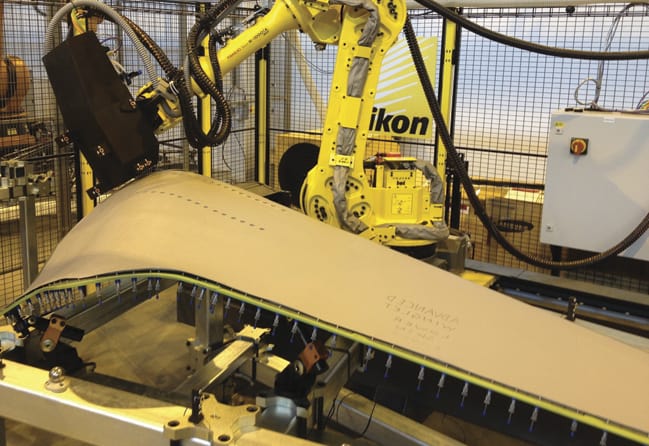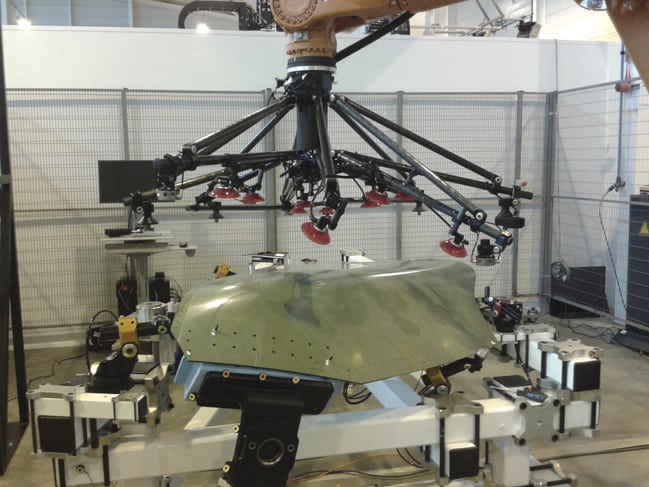Various joining methods are being developed to help manufacturers of composite products save weight, time and cost
If a company can reduce the time and materials used to stick multiple composite components together, it will reduce total production time and cost. So all users of composite structures – manufacturers of aircraft, wind turbine blades, motorsport technology and, increasingly, mainstream automotive equipment – are eager to perfect the bonding process. But relying purely on adhesives is not easy.
“Because we are always chasing weight and cost, bonding parts together is an efficient way of doing that and it could lead to lower-weight structures,” said John Cornforth, head of airframe and special product technologies at GKN Aerospace. “In both metals and composites, we often make individual piece parts, drill holes in them, and then we countersink them, remove the burrs and fasten them together. If you bond it in one hit, it is likely to be a cheaper process.”
But aerospace is a naturally conservative industry and the adoption of adhesive-only joining techniques is slow.

Some aerospace components today, including critical parts, are bonded with adhesives only, such as stiffeners onto panels on winglets. The intent to do more of this is there, but the industry is still nervous about bonding for highly loaded parts. The field where the industry needs a shove, Cornforth suggested, is to design these processes into a manufacturing standard; how to co-cure and marry two components quickly that meet all the regulations. “If you want to design a part for co-cured structures, then those kinds of methods are not in the textbooks,” Cornforth said. “We would like to get to more generic methods that allow you to size a joint that is sufficiently reliable.”
In the aircraft industry, the maximum load factor during authorised during flight is the limit load.
Mechanical fasteners and adhesives are applied, where the fasteners alone could carry the limit load. “Fasteners tend to be used in places where two components are bonded just to stop the initiation of a disbond, where components will come apart,” added Cornforth. The ultimate load to which the aircraft is tested is one-and-a-half times the limit load, so aerospace is truly “belt and braces” on safety and there is little sign of more bonding only in critical parts.
There are three principle types of bonding two or more composite components:
- Co-cured – where both parts have not been cured yet (as supplied, known as ‘green material’) and are cured in the oven together.
- Co-bonded – where one part is pre-cured and another part is not, for example the skin of a winglet and a stiffener where the latter settles into the skin’s shape easily. This would to be done in order to achieve aerospace conformance.
- Secondary bonding – two composite parts that are fully cured and joined. The challenge here is they need to be tooled very accurately to ensure they come together at the right bond line on its whole surface area, especially on large parts.
The main types of bonding adhesive for composites are thermosets and thermoplastics. Among thermosets are epoxy resins, modified polyesters and methyl methacrylates (MMAs). There are some other newer compounds such as bismaleimide resins.
“Thermoplastics can reform at the right conditions, with almost viscose-like properties, and the key industry driver is their application in crash situationsDan Kells, National Composites Centre (NCC)
Thermosets are more traditional, where a chemical reaction sets the material permanently, but thermoplastics are attractive to industry as a result of their high thermal properties and better damage properties.
“Thermoplastics can reform at the right conditions, with almost viscose-like properties, and the key industry driver is their application in crash situations,” explained Dan Kells, collaborative research manager at the National Composites Centre (NCC) in Bristol.
Among adhesives, while epoxy resins are favoured by many manufacturers because they are compatible with the material of the components they join, some companies prefer alternatives. Plymouth-based Princess Yachts, which uses glass-reinforced polymer, resin infused and hand laid, now uses modified polyesters and MMAs as its bonding agent due to the expense of epoxies.

“The adhesive is superior to the laminate [epoxy], so there is no point in looking for a more superior adhesive when you are already outperforming your laminate,” explained Julian Spooner, head of composites at Princess Yachts. “We’ve discussed it with epoxy suppliers but they can’t bring their cost down.”
The method of joining components in luxury yachts needs to consider weight but also speed – most models are semi-custom made with a production line that runs to a drum beat. “You want to apply the quickest process; we want the material to go off [set] as quickly as possible to get the yacht to the next process,” said Spooner.
The automotive industry’s use of composite materials has been rising. At the NCC in Bristol, more projects than ever are run for automotive customers today. Tooling company Expert Tooling in Coventry is running research projects examining the best ways to bond carbon fibre to carbon fibre, and carbon fibre to aluminium depending on the zone of the car. This is part of the Varcity project, a programme involving automotive company Jaguar Land Rover, funded by government innovation agency InnovateUK.
“When you bond aluminium or steel parts to composites, because of the different expansion rates when heated, you need adhesives that are either more flexible or stiffer,” said Gavin Osmond, a graduate research engineer at Expert Tooling. “In places you need traditional mechanical fasteners, for example joining a seat to the carbon-fibre floor.”
“The bonding world is dominated by adhesives or bolts. Bolts are heavy and bonding is generally less trusted for life-critical applicationsAndrew Mills, Cranfield University
The methods they assessed included self-piercing rivets for carbon fibre to carbon fibre and a method using Böllhoff studs that are adhesively bonded onto the carbon, a technique used on the BMW i3 and i8 cars. For the majority of panel-type bonding needs, adhesive-only bonding in the automotive sector is adequate, according to Osmond, but working out which method is best for which car area is the key.
Deploying robots for bonding both composite and metal parts is also increasing. Research and development work is under way at the NCC and the EPSRC Centre for Innovative Manufacturing in Composites (CIMComp). Currently, one of the most practicable applications for robots is in inspection. “At the NCC, we are looking to apply robotics for checking the bonding line is even,” said the NCC’s Dan Kells.
Inspection and the proving of bonds is the elephant in the room, so to speak, for a more mature adhesive-only regime in composite manufacture. “The problem with adhesives is proving,” explained John Cornforth at GKN Aerospace. “You have the difficulty with adhesives in that once you’ve made it all you can do is ensure that you follow a process that leads to a good joint. But you cannot prove that you have a good joint unless you destroy the joint.”
Conversely, with a mechanical join only, companies incur higher costs, especially with titanium bolts, and components often need stress concentration, or thickening, which adds weight and cost. Recognising these inspection problems for adhesives, and the limitations of fasteners, CIMComp has worked on an EPSRC-funded project to embed titanium and steel in carbon fibre.
“The bonding world is dominated by adhesives or bolts,” explained Andrew Mills, principal research fellow, composites manufacturing, at Cranfield University. “Bolts are heavy and bonding is generally less trusted for life-critical applications. Our ‘spiky’ fittings are one solution.”
With metal pieces with projections or spikes, the joints are tolerant to poor preparation and tend to fail in a pseudo-ductile or safe way, rather than an unsafe total failure. The novel embedded inserts programme is working with a large UK motorsport company and a manufacturer of unmanned aircraft. “It is exciting for industry because attaching carbon-fibre components can be so expensive and heavy,” said Mills.




Poll: Should the UK’s railways be renationalised?
I think that a network inclusive of the vehicles on it would make sense. However it remains to be seen if there is any plan for it to be for the...